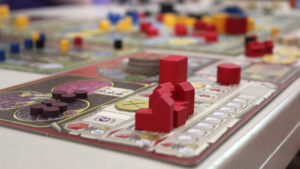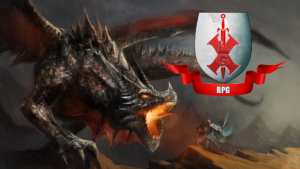This article outlines my own personal experiences with the tabletop gaming scene in Brisbane from the 1960s to today. I encourage others to contribute similar articles and help fill in the gaps of areas I haven’t really explored (such as miniatures). I will feature a different decade every two weeks. Check out part 1 here.
Part 2: 1970s Wargames and Role-playing
During the 1960s I lived on the outskirts of the Brisbane CBD. There were no large shopping malls in the suburbs like today and going into Brisbane was a rare treat. Any games that I had come across until that age of 12 were those that had been bought for me as presents or those that I had seen in shop windows and saved up my allowance to buy (such as Combined Operations – see part 1). In a nutshell, although I had developed a passion for playing board games, there wasn’t much to choose from!
As I entered my teens, my older brother entered the workforce and was based in the city. He knew I collected Airfix tanks and soldiers and that I liked playing board games and on my 13th birthday he bought me a copy of Avalon Hill’s “Panzer Blitz” from a Brisbane store called Hobbycraft. I was wrapped – a product that combined my interest in games and the Second World War!  This was my introduction to wargames. It was full of little cardboard counters with silhouettes of tanks and men and came complete with boards overlaid with a hex grid. This was all new stuff to me. I came to the realisation that this was just like the made up games I had been playing using my Airfix collection but now I had real rules, based on real military data.
This was my introduction to wargames. It was full of little cardboard counters with silhouettes of tanks and men and came complete with boards overlaid with a hex grid. This was all new stuff to me. I came to the realisation that this was just like the made up games I had been playing using my Airfix collection but now I had real rules, based on real military data.
Over the next year I got my brother to take me into town to visit Hobbycraft, which was a small store near the corner of Elizabeth and Albert Street. It mainly stocked typical hobby fare – like models, balsa wood, radio-controlled cars 300 varieties of glue etc. However there was a nook down the back of the shop that held shelves of board games that I never knew had existed – being specialty games that were not stocked by departmental stores. Here I discovered and bought the sister game of “Panzer Blitz’ – “Panzer Leader” and later “Arab-Israeli Wars”. I also discovered Strategy Publications Inc (SPI) magazine at Hobbycraft and
collected quite a few in subsequent years.
Each magazine discussed different historical battles and had a feature article that linked to a game that came with each magazine. The game usually consisted of a paper hex grid map and die-cut cardboard pieces plus a a few combat matrices. Most games were famous battles but there were occasional sci-fi, fantasy or alternate history games. For example, there was “Dixie” that was an American Civil War game set in the 1930’s. The background postulated that the original Civil War ended in a stale-mate and eventually boiled over again in the 20th Century.
I played these new-found games with a few close friends who had similar likes – games, military history, sci-fi and fantasy etc. I suppose we were the original emerging nerds. While other teenagers were taking an interest in the opposite sex, we were excitedly waiting to see what was in the next SPI magazine. As the years rolled by I continued to buy wargames and began to notice strange little rule books starting to appear on the shelf. The production looked very amateurish with basic black and white drawings of Conan-like warriors slaying every imaginable beast. They were not clearly written and had no pieces of boards. I wasn’t sure what to make of them and left them alone. Later I was to discover that these were the very first TSR role-playing books.

I eventually graduated from secondary school and ended up in a job in the city. I was able to explore Brisbane for myself at length and discovered a few more stores hidden away, many of them dealing with these strange little books and lots of miniature figures. One of these was Chess Sales, which became the largest and most popular games store in Brisbane by the end of the 70s, when it became known as Leisuretronics.
I was equipped with cash and, as I was still living with my parents, my pay was spent in a rush on music and games. On pay day I would visit Rocking Horse Records, Hobbycraft and Leisuretronics and just have enough left for rent for mum and dad. Unfortunately, during this time, those friends who shared my interest in games all moved interstate with their families and I was left with a lot of games but no-one to play them with. I became a collector and turned to my younger brother (who was ten at this time) teaching him the ropes of the more easier games. During this time I had branched out of historical wargames and bought other titles like, ‘Outdoor Survival” and “The Battle of Five Armies”.
As luck has it my employer posted me and another guy (Greg McMahon) who was a year or two younger than me to a location on Kangaroo Point, under an older supervisor. The supervisor went on long service leave for 6 months leaving me in charge. Greg and I discovered that, by coming in at 7am and working at a furious pace, we could finish all the work for the day by midday. The rest of the day we would read or play chess. Then one day I brought in “Outdoor Survival” and Greg McMahon was hooked. His cousin was studying
at QIT and would drop over to Kangaroo Point to join in. Then when the school holidays hit, Greg’s younger brother, Anthony, joined us. I became good friends with the McMahon family and, when the weekend arrived, I would load up the car with games and head over to their family home at the Gap. During this time, it became obvious that Anthony McMahon was far more interested in board games than the other siblings and I ended up playing more games with him.
 One fateful day I ended up buying a copy of “Empire of the Petal Throne” from Hobbycraft. It was in a box and contained a hex map of a city and of a continental land mass, plus a thick rule book. The book described a rule system, the history of the world of Tekumel, its races, creatures and magical items. Being totally ignorant of role-playing games, I thought this was
One fateful day I ended up buying a copy of “Empire of the Petal Throne” from Hobbycraft. It was in a box and contained a hex map of a city and of a continental land mass, plus a thick rule book. The book described a rule system, the history of the world of Tekumel, its races, creatures and magical items. Being totally ignorant of role-playing games, I thought this was
a board game. I got together with Anthony and tried to play it as such – moving about the board and encountering things on the random encounter table. We had no concept of what a GM was or that you had to write adventures for the game, using the rule set. Naturally, we gave up on EPT. It was a confusing oddity that would have got left on the bottom of the game pile, except Anthony asked to borrow it for a while so he could read the rule book in depth.


